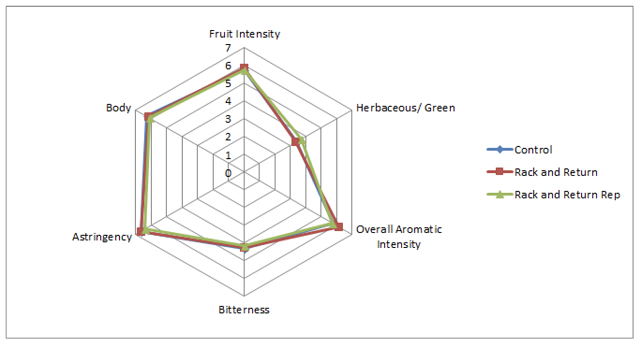The Impact of Racking and Returning on Wine Quality (2017)
Corry Craighill
Sunset Hills Vineyard
Summary
This study examines the impact of racking and returning during aging on red wine quality. Petit Verdot wine was split into two identical barrels. Once malolactic conversion was completed, one barrel was racked into tank, the barrel was pressure washed and ozonated, and then the wine was returned to the barrel and topped. The other barrel had no treatment. All other treatments between wines were identical. No major chemical differences were apparent between treatments. VA was slightly lower in the racked wine. Some sulfide parameters were lower in the racked wine, although whether these differences would impact flavor is hard to say. For the triangle test, of 20 people who answered, 7 people chose the correct wine (35%), suggesting that these wines were not significantly different. In general, of those who correctly identified the wines, 2 had no preference, 2 preferred the control, and 3 preferred the rack and returned wine. For the descriptive analysis, there were no trends for the descriptors used in this study. Judges commented that these wines were very extracted, which may have masked differences between wines. In the future, this study should be repeated on less intense grape varieties. Furthermore, the wine should be allowed to age more in future studies.
Introduction
Towards the end of malolactic conversion in red winemaking, winemakers often choose to rack the wine out of the barrel and then return it to either the same barrel (cleaned), or to different barrels. There are several reasons for doing this: to remove the gross lees from the wine, to incorporate more oxygen to help with reduction in the wine, and to encourage the malolactic bacteria to consume the remaining malic acid and sugars in the wine before extended aging. This practice may also help encourage diacetyl consumption by malic acid bacteria as well. However, this incorporation of air may also encourage the growth of unwanted microorganisms. Racking and returning can also be a very labor-intensive practice, and thus it should not be performed if it does not lead to satisfactory results in the resulting wine quality. The purpose of this study was to examine the impact of racking and returning Petit Verdot wine after completion of malolactic conversion, to determine whether wine quality is affected.
Results and Discussion
No major chemistry differences were apparent between treatments. VA was slightly lower in the racked wine. Some sulfide parameters were lower in the racked wine, although whether these differences would impact flavor is hard to say. For the triangle test, of 20 people who answered, 7 people chose the correct wine (35%), suggesting that these wines were not significantly different. In general, of those who correctly identified the wines, 2 had no preference, 2 preferred the control, and 3 preferred the rack and returned wine. For the descriptive analysis, there were no trends for the descriptors used in this study. Judges commented that these wines were very extracted, which may have masked differences between wines. In the future, this study should be repeated on less intense grape varieties. Furthermore, the wine should be allowed to age more in future studies.







Methods
2017 Petit Verdot was processed into a tank. 30ppm sulfur dioxide was added throughout processing and mixed in with pumpover. 15g/hL of D21 yeast was added. The tank received two pumpovers/day during fermentation, adjusted accordingly throughout the fermentation. 3g/L tartaric acid was added during fermentation. The Petit Verdot was pressed, separating the press cut after 0.6 bar. The wine settled overnight in tank. It was racked to neutral barrels after 24 hours. The barrels are monitored for MLF. Once complete, 50ppm of sulfur dioxide was added and barrels topped.
The rack and return happened once MLF was complete. One barrel was aeratively racked to tank. The barrel was pressure washed and ozoned, and the wine was racked back to the same barrel and topped with the same lot of wine. The other barrel remained unracked and also topped from the same lot of wine.
These wines were tasted on May 16. For the triangle test, descriptive analysis, and preference, anybody who did not answer the form were removed from consideration for both triangle, degree of difference, and preference. Additionally, anybody who answered the triangle test incorrectly were removed from consideration for degree of difference and preference. Additionally, any data points for preference which did not make sense (such as a person ranking a wine and its replicate at most and least preferred, when they correctly guessed the odd wine) were removed.
In order to balance the data set to perform statistical analysis for descriptive analysis, any judge who had not fully completed the descriptive analysis ratings were removed. There was a final data set of 3 groups, each with 7 judges (considered as replications within groups, and groups were considered as assessors). Data was analyzed using Panel Check V1.4.2. Because this is not a truly statistical set-up, any results which are found to be statistically significant (p<0.05) will be denoted as a “strong trend” or a “strong tendency,” as opposed to general trends or tendencies. The statistical significance here will ignore any other significant effects or interactions which may confound the results (such as a statistically significant interaction of Judge x Wine confounding a significant result from Wine alone). The descriptors used in this study were Fruit Intensity, Herbaceous/Green, Overall Aromatic Intensity, Bitterness, Astringency, and Body.
